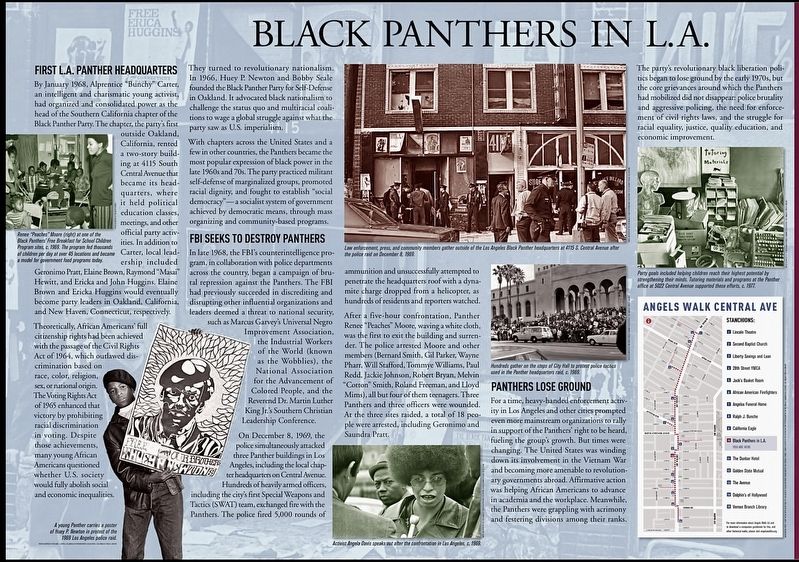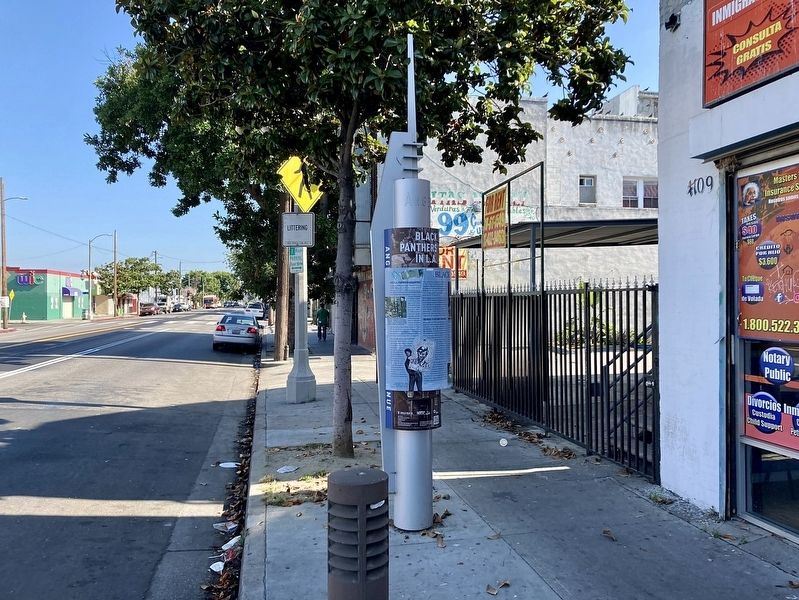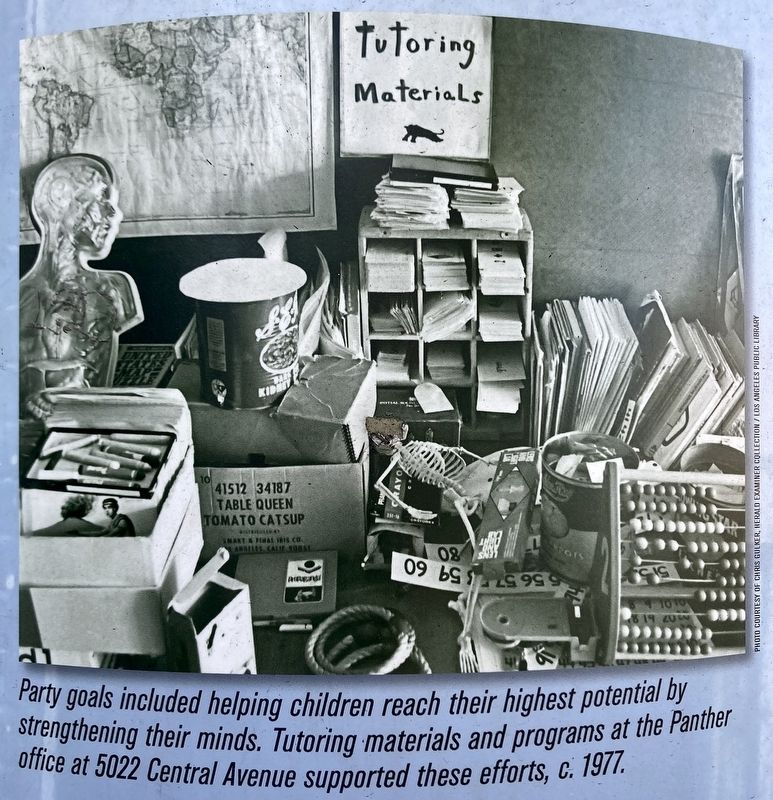South Los Angeles in Los Angeles County, California — The American West (Pacific Coastal)
Black Panthers in L.A.
First L.A. Panther Headquarters
By January 1968, Alprentice "Bunchy" Carter, an intelligent and charismatic young activist, had organized and consolidated power as the head of the Southern California chapter of the Black Panther Party. The chapter, the party's first outside Oakland, California, rented a two-story building at 4115 South Central Avenue that became its headquarters, where it held political education classes, meetings, and other official party activities. In addition to Carter, local leadership included Geronimo Pratt, Elaine Brown, Raymond "Masai" Hewitt, and Ericka and John Huggins. Elaine Brown and Ericka Huggins would eventually become party leaders in Oakland, California, and New Haven, Connecticut, respectively.
Theoretically, African Americans' full citizenship rights had been achieved with the passage of the Civil Rights Act of 1964, which outlawed discrimination based on race, color, religion, sex, or national origin. The Voting Rights Act of 1965 enhanced that victory by prohibiting racial discrimination in voting. Despite those achievements, many young African Americans questioned whether U.S. society would fully abolish social and economic inequalities.
They turned to revolutionary nationalism. In 1966, Huey P. Newton and Bobby Seale founded the Black Panther Party for Self-Defense in Oakland. It advocated black nationalism to challenge the status quo and multiracial coalitions to wage a global struggle against what the party saw as U.S. imperialism.
With chapters across the United States and a few in other countries, the Panthers became the most popular expression of black power in the late 1960s and 70s. The party practiced militant self-defense of marginalized groups, promoted racial dignity, and fought to establish "social democracy" — a socialist system of government achieved by democratic means, through mass organizing and community-based programs.
FBI Seeks to Destroy Panthers
In late 1968, the FBI's counterintelligence program, in collaboration with police departments across the country, began a campaign of brutal repression against the Panthers. The FBI had previously succeeded in discrediting and disrupting other influential organizations and leaders deemed a threat to national security, such as Marcus Garvey's Universal Negro Improvement Association, the Industrial Workers of the World (known as the Wobblies), the National Association for the Advancement of Colored People, and the Reverend Dr. Martin Luther King Jr.'s Southern Christian Leadership Conference.
On December 8, 1969, the police simultaneously attacked three Panther buildings in Los Angeles, including the local chapter headquarters on Central Avenue. Hundreds of heavily armed officers, including the city's first Special Weapons and Tactics (SWAT) team, exchanged fire with the Panthers. The police fired 5,000 rounds of ammunition and unsuccessfully attempted to penetrate the headquarters roof with a dynamite charge dropped from a helicopter, as hundreds of residents and reporters watched.
After a five-hour confrontation, Panther Renee "Peaches" Moore, waving a white cloth, was the first to exit the building and surrender. The police arrested Moore and other members (Bernard Smith, Gil Parker, Wayne Pharr, Will Stafford, Tommye Williams, Paul Redd, Jackie Johnson, Robert Bryan, Melvin "Cotton" Smith, Roland Freeman, and Lloyd Mims), all but four of them teenagers. Three Panthers and three officers were wounded. At the three sites raided, a total of 18 people were arrested, including Geronimo and Saundra Pratt.
Panthers Lose Ground
For a time, heavy-handed enforcement activity in Los Angeles and other cities prompted even more mainstream organizations to rally in support of the Panthers' right to be heard, fueling the group's growth. But times were changing. The United States was winding down its involvement in the Vietnam War and becoming more amenable to revolutionary governments abroad. Affirmative action was helping African Americans to advance
in academia and the workplace. Meanwhile, the Panthers were grappling with acrimony and festering divisions among their ranks.
The party's revolutionary black liberation politics began to lose ground by the early 1970s, but the core grievances around which the Panthers had mobilized did not disappear: police brutality and aggressive policing, the need for enforcement of civil rights laws, and the struggle for racial equality, justice, quality education, and economic improvement.
Erected 2020 by City of Los Angeles.
Topics. This historical marker is listed in these topic lists: African Americans • Civil Rights • Law Enforcement. A significant historical month for this entry is January 1968.
Location. 34° 0.535′ N, 118° 15.397′ W. Marker is in Los Angeles, California, in Los Angeles County. It is in South Los Angeles. Marker is on Central Avenue south of 41st Street, on the right when traveling south. Touch for map. Marker is at or near this postal address: 4111 S Central Ave, Los Angeles CA 90011, United States of America. Touch for directions.
Other nearby markers. At least 8 other markers are within walking distance of this marker. California Eagle (within shouting distance of this marker); Ralph J. Bunche (about 500 feet away, measured in a direct line); The Downbeat Club (about 600 feet away); Dunbar Hotel (about 700 feet away); Apex / Club Alabam (about 800 feet away); Florence Mills Theatre (approx. 0.2 miles away); Golden State Mutual (approx. 0.2 miles away); Ralph Bunche Home (approx. 0.2 miles away). Touch for a list and map of all markers in Los Angeles.
Also see . . . Angeles Walk L.A. Self-guided walking tours of historic neighborhoods in Los Angeles. The Black Panthers marker is part of the Central Avenue walk. (Submitted on June 23, 2023.)
Credits. This page was last revised on July 26, 2023. It was originally submitted on June 23, 2023, by Craig Baker of Sylmar, California. This page has been viewed 212 times since then and 123 times this year. Photos: 1, 2, 3. submitted on June 23, 2023, by Craig Baker of Sylmar, California.


